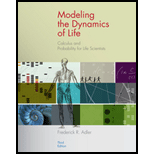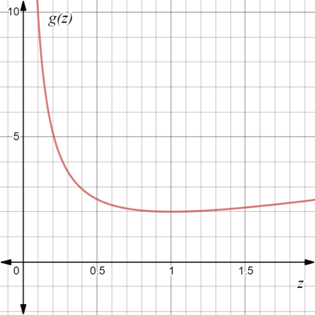
To calculate: The first and second derivative of the function
Answer to Problem 20E
The value of first derivative of the function is

Explanation of Solution
Given information:
The function
Formula used:
Let a function g be continuous on closed interval
If first derivative of the function is greater than zero that is
If first derivative of the function is less than zero that is
If second derivative of the function is greater than zero that is
If second derivative of the function is less than zero that is
The point where the graph changes it nature is known as the point of inflection.
Power rule of differentiation,
Calculation:
Consider the provided function
Rewrite the function with help negative exponent that is,
Evaluate the first derivative of the function.
Apply sum rule of differentiation,
Apply the power rule of differentiation,
Evaluate the second derivative of the function, differentiate the first derivative again with respect to z .
Apply sum rule of differentiation,
Apply the power rule of differentiation,
Recall if first derivative of the function is greater than zero that is
If first derivative of the function is less than zero that is
If second derivative of the function is greater than zero that is
If second derivative of the function is less than zero that is
To sketch the graph of the function
Observe that first derivative of the function
Equate
When
When
So,
Next observe that second derivative of the function
Therefore, the graph of the function

Thus, the value of first derivative of the function is
Want to see more full solutions like this?
Chapter 2 Solutions
Modeling the Dynamics of Life: Calculus and Probability for Life Scientists
 Advanced Engineering MathematicsAdvanced MathISBN:9780470458365Author:Erwin KreyszigPublisher:Wiley, John & Sons, Incorporated
Advanced Engineering MathematicsAdvanced MathISBN:9780470458365Author:Erwin KreyszigPublisher:Wiley, John & Sons, Incorporated Numerical Methods for EngineersAdvanced MathISBN:9780073397924Author:Steven C. Chapra Dr., Raymond P. CanalePublisher:McGraw-Hill Education
Numerical Methods for EngineersAdvanced MathISBN:9780073397924Author:Steven C. Chapra Dr., Raymond P. CanalePublisher:McGraw-Hill Education Introductory Mathematics for Engineering Applicat...Advanced MathISBN:9781118141809Author:Nathan KlingbeilPublisher:WILEY
Introductory Mathematics for Engineering Applicat...Advanced MathISBN:9781118141809Author:Nathan KlingbeilPublisher:WILEY Mathematics For Machine TechnologyAdvanced MathISBN:9781337798310Author:Peterson, John.Publisher:Cengage Learning,
Mathematics For Machine TechnologyAdvanced MathISBN:9781337798310Author:Peterson, John.Publisher:Cengage Learning,






